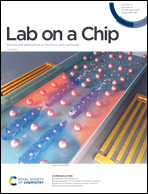High-throughput functional profiling of single adherent cells via hydrogel drop-screen†
Abstract
Single-adherent-cell phenotyping on an extracellular matrix (ECM) is essential to determine cellular biological functions, such as morphological adaptations and biomolecule secretions, correlated to medical treatments and metastasis, yet there is no available platform for such high-throughput screening. Here, a novel hydrogel drop-screen device was developed to rapidly measure large-scale single-cell morphologies and multiple secretions on substrates for phenotype profiling. Single cells were first anchored to microfluidically fabricated gelatin particles providing mechanical stimulations similar to those from ECM in vivo. The cellular morphologies were then examined by quantifying the amount of cytoskeleton expressed on the particles. With droplet encapsulation, adherent single-cell multiplexed secretion analysis of a disintegrin and metalloproteinases (ADAMs) and matrix metalloproteinases (MMPs) was conducted at a throughput of ∼102 cells per second, revealing distinct functional heterogeneities associated with extracellular mechanical stimulations. The level of cell heterogeneity increased with increasing substrate stuffiness. Moreover, because of the promising screening capability, a database related to both nontumorigenic and tumorigenic breast cells (MCF10A, MCF-7, and MDA-MB-231) was constructed. The respective cell distributions and heterogeneities based on the morphologies and secreted bioindicators, such as MMP-2, MMP-3, MMP-9, and ADAM-8, were measured and found to correspond to the progress of tumor metastasis.



 Please wait while we load your content...
Please wait while we load your content...